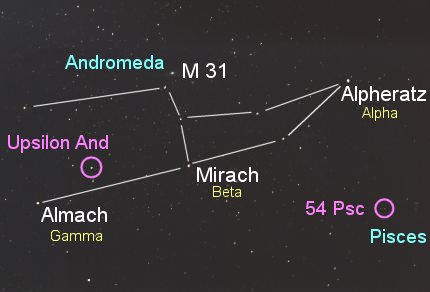 The circle shows the location of the class F star Upsilon
Andromedae (in the constellation Andromeda). A system of four planets orbits the star.
The circle shows the location of the class F star Upsilon
Andromedae (in the constellation Andromeda). A system of four planets orbits the star.
THE PLANETS
*Planet 1 orbits in 4.62 days, has a mass at least 0.62 times that of Jupiter, and is 0.06 astronomical units from the star (8.9 million kilometers, 5.5 million miles, or 15 percent Mercury's distance from the Sun).*Planet 2 orbits in 238 days, has a mass at least 1.8 times that of Jupiter, and is 0.86 astronomical units from the star (129 million kilometers, 80 million miles.
*Planet 3 orbits in 3.6 years, has a mass at least 10.2 times that of Jupiter, and is 2.55 astronomical units from the star (383 million kilometers, 236 million miles, or 1.67 times Mars's distance from the Sun). The orbits of planets 2 and 3 are moderately eccentric.
*Planet 4 orbits in 10.5 years, has a mass at least that of Jupiter, and like Jupiter is 5.2 astronomical units from its star.